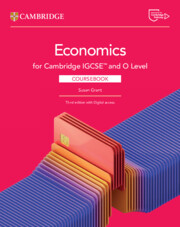Cambridge IGCSE™ and O Level Economics Digital Teacher's Resource
Overview
Teaching inspiration, lesson ideas and downloadable worksheets: our digital teacher's resource is the perfect tool to support your day-to-day lesson planning. It follows the same chapter structure as the coursebook, so you can confidently use it to support the content of your lessons. Discover additional support for your teaching, including advice on areas that students may find challenging and formative assessment guidance. This digital teacher's resource supports the Cambridge IGCSE™ , IGCSE (9-1) and O Level Economics syllabuses (0455/0987/2281) for examination from 2027. You can access your digital resource via Cambridge GO, where you will also find suggested answers for all questions in the coursebook and workbook.
Features
- Teaching plans provide topic overviews of the content knowledge, skills and learning objectives.
- Clear guidance through starter, main and plenary activities to support lesson planning, differentiation and assessment for learning.
- Learning intentions and success criteria are included so you can easily copy and paste them into your own lesson plans.
- 'Language support' feature provides additional guidance on how to support students with language, particularly areas they may find challenging.
- 'Common misconceptions' feature explains how to identify where students are struggling and how to overcome these challenges.
- Suggested teaching hours for each chapter alongside a breakdown of the topics to guide you through the syllabus.
- Downloadable worksheets provide extra practice opportunities for key topics and language.
- Suggested answers for all questions in the coursebook and workbook.
- Dedicated support to help teachers deliver better learning and assessment with our digital teacher's resource.
- Our digital resources are user-friendly and designed with accessibility in mind to support all students.
- This publication meets the requirements of the EPUB Accessibility specification with conformance to WCAG 2.2 Level AA.
Contents
- Introduction
- Syllabus mapping
- How to use this series
- How to use this Teacher's Resource
- About the authors
- About the syllabus
- About the examination
- Approaches to teaching and learning
- Section 1. The basic economic problem
- Chapter 1. The nature of the economic problem
- Chapter 2. Factors of production
- Chapter 3. Opportunity cost
- Chapter 4. Production possibility curve diagrams
- Section 2. The allocation of resources
- Chapter 5. The role of markets in allocating resources
- Chapter 6. Demand
- Chapter 7. Supply
- Chapter 8. Price determination
- Chapter 9. Price changes
- Chapter 10 Price elasticity of demand (PED)
- Chapter 11. Price elasticity of supply (PES)
- Chapter 12. Market economic system
- Chapter 13. Market failure
- Chapter 14. Mixed economic system
- Section 3. Microeconomic decision makers
- Chapter 15. Money and banking
- Chapter 16. Households
- Chapter 17. Workers
- Chapter 18. Firms
- Chapter 19. Firms and production
- Chapter 20. Firms costs, revenue and objectives
- Chapter 21. Types of markets
- Section 4. Government and the macroeconomy
- Chapter 22. Government macroeconomic intervention
- Chapter 23. Fiscal policy
- Chapter 24. Monetary policy
- Chapter 25. Supply-side policy
- Chapter 26. Economic growth
- Chapter 27. Employment and unemployment
- Chapter 28. Inflation and deflation
- Section 5. Economic development
- Chapter 29. Living standards
- Chapter 30. Poverty
- Chapter 31. Population
- Chapter 32. Differences in economic development between countries
- Section 6. International trade and globalisation
- Chapter 33. Specialisation and free trade
- Chapter 34. Globalisation and trade restrictions
- Chapter 35. Foreign exchange rates
- Chapter 39. Current account balance of payments.
Brighter Thinking Blog
Keep up to date with the latest classroom tips and educational trends from our brighter thinkers.
Visit the blogCatalogues and Ordering
Looking for something in particular or just browsing? View our catalogues to see our full range of print and digital books.
View and downloadAdvice on useful tools
Advice on useful tools, activities and timetabling from teachers experiencing school closures.
Cambridge GO
All our supporting resources have now moved to Cambridge GO – the new home for your Cambridge digital content.
Listen to our podcast
Listen to our podcast to discover teaching inspiration & advice from leading educational thinkers.





